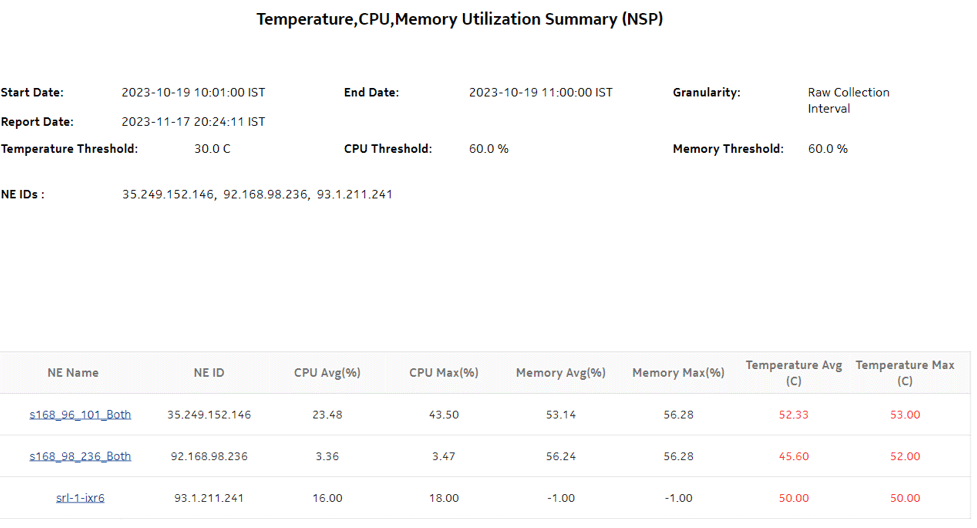Temperature, CPU, Memory Utilization Summary (NSP) report
Temperature, CPU, Memory Utilization Summary (NSP) report overview
The Temperature, CPU, Memory Utilization Summary (NSP) report differs from the Temperature, CPU, Memory Utilization Summary report by including throughput data for NEs managed by the NFM-P only, MDM (model-driven Nokia) only, or NFM-P+MDM-mediated NEs. The content and format of the Temperature, CPU, Memory Utilization Summary (NSP) report vary from the NFM-P-only Temperature, CPU, Memory Utilization Summary report to accommodate its model-driven approach.
The Temperature, CPU, Memory Utilization Summary (NSP) report shows the maximum and average temperature and memory and CPU usage for selected NEs. The default display is a table displaying details. By default, the table is sorted according to the NE Name column. Table sorting is enabled for the CPU Memory Average and Maximum columns.
To generate meaningful average temperature data, Nokia recommends using raw or hourly interval statistics.
Memory Usage is computed in the report using the following formula: [memory in use / (allocated memory + available memory) * 100]. The calculation is displayed at the footnote section of the reports.
If a null value is returned by the NE for CPU or Memory, the report displays the result as -1. If a null value is returned by the NE for Temperature, the report displays N/A.
Utilization results are colored red when utilization reaches or exceeds user-defined thresholds. Thresholds are defined separately. The default value for the temperature threshold is 30°C. The default value for the memory and CPU thresholds is 60%.
The following temperatures can be reported by the NE when no temperature sensor is available. These temperatures are invalid and will not be displayed in the report.
Limitations
Minimum and maximum throughput aggregation cannot be compared with the minimum and maximum throughput values generated from raw granularity.
Prerequisites
The following table describes the aggregation rules that must be enabled and telemetry subscriptions that must be configured for the NEs on which statistics are to be collected. The aggregation rules must be enabled to view the report for granularities other than raw data; see How do I configure analytics aggregation?. Enable aggregation and configure telemetry subscriptions; see the Telemetry information on the Network Developer Portal and the NSP Data Collection and Analysis Guide. For the report prerequisites for NFM-P-managed NEs, see Table 14-43, Temperature, CPU, Memory Utilization Summary report prerequisites.
See information in the NSP NFM-P Statistics Management Guide about creating or modifying a specific MIB statistics policy using a bottom-up method.
Table 18-26: Temperature, CPU, Memory Utilization Summary (NSP) report prerequisites
|
Aggregator name |
Monitored object class |
Statistics class |
Statistics collection |
NE types |
|---|---|---|---|---|
|
md-aggr:/md-aggr-base/telemetry-system-info/system |
Card Memory pool Shelf |
telemetry:/base/system-info/system |
Telemetry statistics |
7750 MD SR Classic NE with gRPC telemetry collection enabled 7250 IXR variants |
|
md-aggr:/md-aggr-base/telemetry-hardware/temperature |
Card Port Shelf |
telemetry:/base/hardware/temperature |
Telemetry statistics |
7750 MD SR Classic NE with gRPC telemetry collection enabled 7250 IXR variants |
Report characteristics
The following table lists the principal report characteristics.
Table 18-27: Temperature, CPU, Memory Utilization Summary (NSP) report characteristics
|
Characteristic |
Value | |||||
|---|---|---|---|---|---|---|
|
Data type |
Statistics NE configuration information | |||||
|
Source database |
Auxiliary database | |||||
|
NE types supported |
7750 MD SR Classic NEs with gRPC telemetry collection enabled All 7250 IXR variants | |||||
|
Report inputs |
Prompt |
Notes | ||||
|
End date |
Calendar date or relative date (for example, two days ago) and time | |||||
|
Granularity |
Aggregation types: | |||||
|
Report range |
Length of time to be reported, in minutes (minutes, min), hours (hours, h), days (days, d), or months (months, m) | |||||
|
Node Type |
Select individual NE types or click Select All. Search using partial names or wildcard (%). | |||||
|
Site (or Site Name Pattern) |
Search using partial names or wildcard (%). | |||||
|
Sites |
Select individual sites or click Select All. Search using partial names or wildcard (%). | |||||
|
Temperature unit (C/F) |
Default is Celsius | |||||
|
Temperature threshold |
Data at or above thresholds will display in red. | |||||
|
CPU threshold | ||||||
|
Memory threshold | ||||||
|
Logo Resource ID |
The logo to add to the report. Enter the resource ID for the logo image uploaded to the Images folder, if any. If no logo ID is provided, the logo area will be blank. | |||||
|
Logo Position |
Choose Left, Middle or Right. The logo will be placed on the left of the first page of the report for both the left and middle options. | |||||
|
Show report output on one page |
Select the check box to enable pagination. Note: Using the Show report output on one page option when creating reports as drill-downs may impact report rendering time. Nokia recommends disabling the Show report output on one page option when creating reports. | |||||
|
Drill-down support |
Yes—Open the Temperature, CPU, Memory Details report for the selected NE. | |||||
Note: If there is no data for the input date and range, the report displays -1.00 in the table columns.
For SRL NEs (7250 IXR variants), the report does not include memory statistics.
